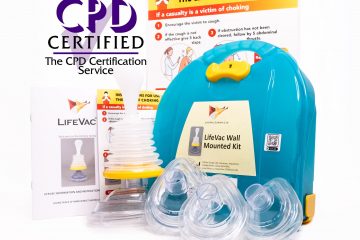Our most frequently asked questions about our LifeVac® anti-choking device.
LifeVac® is a class 1 medical device: a revolutionary non-invasive anti-choking device to be used when choking emergencies arise and first aid BLS choking protocol has failed or cannot be performed. LifeVac® is made from proven and tested materials and has a patented one-way safety valve system. This means when applied no air can be forced through the interchangeable sized masks, therefore, when pulled, this generates the perfect suction to dislodge an obstruction of the upper airway.
LifeVac® is medically registered and regulated by governing bodies around the world, such as the FDA, MHRA, TGA, MOH, IMA, AMAR, HPFB, CE and many more. It’s the only legal, non-invasive proven airway clearance device on the market to save lives and prevent emergencies escalating – which you can purchase directly from the manufacturers here. From choking accident prevention at schools to the hospitality industry, our LifeVac medical devices are already equipped in most industries to help save people in a choking emergency.
Yes, LifeVac® can proudly say it is the only airway clearance device or suction device with independent medical testing, peer-reviewed medical publications and medical abstracts covering safety, effectiveness, lives saved, comparison studies and ease of use.
With every life saved with LifeVac®, we encourage our customers to report a life saved to assist with our choking aid research to save even more lives and receive a free replacement. Discover our success stories and testimonials to see how we are raising awareness of choking to prevent choking deaths across the world with LifeVac®.
Yes, anyone can use LifeVac®; we recommend using LifeVac® when Resuscitation Council Guidelines (BLS protocol) fails or cannot be performed. This is where LifeVac® has saved thousands of lives, when standard BLS has failed or cannot be performed. Resuscitation Guidelines are reviewed every 5 years and created by a body called ILCOR (International Liaison Committee); this committee is made up of resuscitation council members from all over the world.
In the last review (2019/20), ILCOR stated, “While we recognise they have saved lives, there is not enough evidence to encourage or discourage their use”. Since then, LifeVac® has saved a further 2,300 lives and gained 8 more peer reviewed medical publications covering lives saved, comparison studies, ease of use, safety and effectiveness.
We are certain non-invasive hand-held suction devices will become part of the standard first aid choking protocol at some point in the future as LifeVac® is saving lives when BLS first aid fails. In addition, BLS choking protocol is only 70% effective when performed correctly in a perfect situation. You also have to remember these are “guidelines” not “laws.” LifeVac® is not a first aid device yet and does not claim to be a first aid device. LifeVac® is a legal option to be used in a choking emergency.
Yes, LifeVac® can be used if choking occurs at any point, full or partial. If you are unable to breathe, speak, cough, or spit, then it is a viable option to begin using a LifeVac®. When choking protocol fails, LifeVac® can quickly dislodge an airway obstruction and help save a life.
Our LifeVac® devices can be used in any position, from sitting and standing to lying down.
Yes, the LifeVac® anti-choking device can be self-applied and has also been used like this to save many lives.
Whilst LifeVac® is currently recommended for any choking victim over 10kg, users can use this device on choking victims under 10 kg with the paediatric mask attached at their own risk.
However, with the correct application, there have been hundreds of cases where parents have saved a baby with a LifeVac® device. Young children and babies are the second highest risk group when it comes to choking, so we make it our mission to raise awareness of choking. In the event of standard first aid choking protocol failing, our LifeVac® device is the only non-invasive method to protect your children in a choking emergency as a last resort.
We recommend up to 5 applications if the casualty is unconscious, the only circumstances where LifeVac can be applied more than the recommended 5 applications on an unconscious casualty is if another person is performing CPR.
With a firm PUSH and TWIST motion in a choking emergency.
No, LifeVac® comes with interchangeable masks clearly identified by colour-coded labels. Unfortunately, one size mask does not fit all, so we have created a device that can be used on everyone by simply changing the mask. LifeVac® has saved lives from 2 months old to 104 years old.
No, LifeVac® device does not expire. We chose and tested materials that have a 100-year shelf life, but are fully recyclable, and will perform in very hot/cold climates. Our LifeVac device will not have to be replaced unless they have been used to save someone’s life from choking – as LifeVac is a single use lifesaving apparatus. Only the masks will need to be replaced every 2 years; the expiration date can be found within your kits on the unique label.
Yes, we offer training, ‘train the trainer’ training, ‘free video training’ and our ‘CPD Certified e-learning training’ to educate you on choking and when to use our LifeVac® devices. Every kit also comes with an easy to scan QR code which takes everyone to a free training video, our kits also come with a 22-page multilingual instruction booklet.
It is recommended to add LifeVac® to first aid training courses due to the ease of use and due to the potential consistency of use. The training should consider the availability and non-availability of LifeVac® devices. Once available, LifeVac® can be used almost instantaneously once first aid BLS choking protocol has failed or cannot be performed. Training on LifeVac® is easy and “Train the Trainer” programs are available.
LifeVac® is single-use due to cross-contamination, but if you let us know you have used LifeVac® like many others have we will replace it free of charge.
Yes, barotrauma, cardiac arrest, brain damage, and death.
Barotrauma is usually associated with positive pressure, usually of the lower respiratory tract rather than the upper airway, resulting from high inflation pressures and damaging the lung parenchyma. Suction devices which generate a ‘negative’ (sub-atmospheric) pressure will not damage distal tissues beyond the larynx.
Because the LifeVac is non-invasive, there is no risk of any tubes pushing the obstruction further down or causing oral damage, making it a safer clearance device. Also, no tubes can become blocked, which will render the equipment useless if only part of the obstruction has been removed.
Any more questions about LifeVac®?
Contact us today at +44 (0)1271 316044 if you have any questions about our LifeVac® anti-choking device or our product range. We’ll be happy to assist you.
At LifeVac Europe, with every LifeVac® choking device we manufacture, we test for durability, quality and function to keep users safe and equipped with the best and safest products for emergency use.
Buy LifeVac devices or bundles today and safeguard those around you from choking should disaster strike.




















